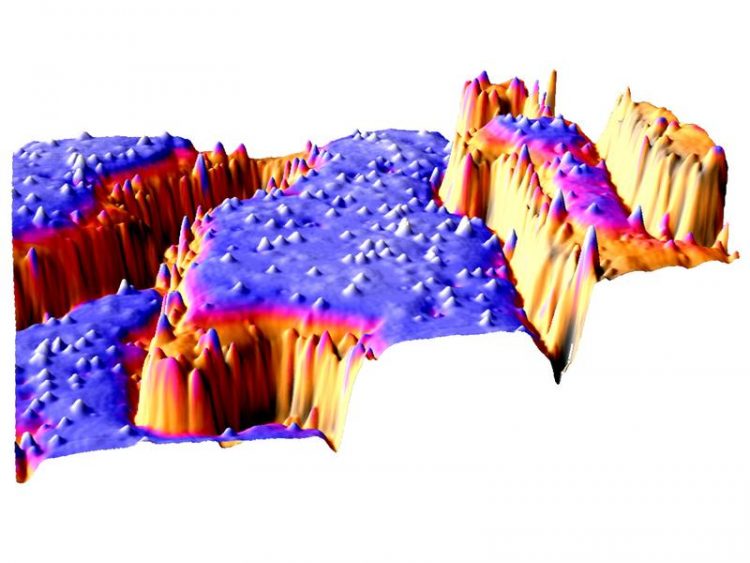Tiny Step Edges, Big Step for Surface Science

Tiny step edges on titanium oxide surfaces
It can be found in toothpaste, solar cells, and it is useful for chemical catalysts: titanium dioxide (TiO2) is an extremely versatile material. Alhough it is used for so many different applications, the behaviour of titanium oxide surfaces still surprises.
Professor Ulrike Diebold and her team at the Vienna University of Technology managed to find out why oxygen atoms attach so well to tiny step edges at titanium oxide surfaces. Electrons accumulate precisely at these edges, allowing the oxygen atoms to connect more strongly. In solar cells, this effect should be avoided, but for catalysts this can be highly desirable.
Microscope Pictures of Titanium Oxide Surfaces
Titanium oxide is Ulrike Diebold’s favourite material. In her latest publication, she and her team studied the behaviour of titanium oxide surfaces using scanning tunnelling microscopy and atomic force microscopy.
Titanium oxide can be used for solar cells. In the so-called Graetzel cell, an inexpensive but inefficient type of solar cell, it plays the central role. “In a solar cell, we want electrons to move freely and not attach to a particular atom”, says Martin Setvin, first author of the publication, which has now appeared in the journal “Angewandte”.
The opposite is true for catalysts: For catalytic processes, it is often important that electrons attach to surface atoms. Only at places where such an additional electron is located can oxygen molecules attach to the titanium oxide surface and then take part in chemical reactions.
Electrons Distort the Crystal Structure
Usually, it takes a considerable amount of energy to have the electrons bond to a particular atom. “When an electron is localized at a titanium atom, the electric charge of the atom is changed, and due to electrostatic forces, the titanium oxide crystal is distorted”, says Ulrike Diebold. To create this lattice distortion, energy has to be invested – and therefore this effect does not usually occur by itself.
However, the surface of titanium oxide is never completely flat. On a microscopic scale, there are tiny steps and edges, many of them with a height of only one atomic layer. At these edges, electrons can localize quite easily. The atoms at the edge only have neighbours on one side, and therefore no major lattice distortions are created when these atoms receive an additional electron and change their charge state. “We have observed that oxygen molecules can connect to the surface precisely at these locations”, says Diebold.
Better Solar Cells, More Efficient Catalysts
Important conclusions for technology can be drawn from this: for photovoltaics, such step edges should be avoided, for catalysts this newly discovered effect yields great opportunities. Surfaces could be microstructured to exhibit many such edges, making them extremely effective catalysts.
Further Information:
Prof. Ulrike Diebold
Institute of Applied Physics
Vienna University of Technology
Wiedner Hauptstraße 8
M: +43-664-605883467
ulrike.diebold@tuwien.ac.at
Martin Setvin, PhD
Institute of Applied Physics
Vienna University of Technology
Wiedner Hauptstraße 8
T: +43-1-58801-13470
martin.setvin@tuwien.ac.at
Media Contact
More Information:
http://www.tuwien.ac.at/en/news/news_detail/article/8732/All latest news from the category: Life Sciences and Chemistry
Articles and reports from the Life Sciences and chemistry area deal with applied and basic research into modern biology, chemistry and human medicine.
Valuable information can be found on a range of life sciences fields including bacteriology, biochemistry, bionics, bioinformatics, biophysics, biotechnology, genetics, geobotany, human biology, marine biology, microbiology, molecular biology, cellular biology, zoology, bioinorganic chemistry, microchemistry and environmental chemistry.
Newest articles

A universal framework for spatial biology
SpatialData is a freely accessible tool to unify and integrate data from different omics technologies accounting for spatial information, which can provide holistic insights into health and disease. Biological processes…

How complex biological processes arise
A $20 million grant from the U.S. National Science Foundation (NSF) will support the establishment and operation of the National Synthesis Center for Emergence in the Molecular and Cellular Sciences (NCEMS) at…

Airborne single-photon lidar system achieves high-resolution 3D imaging
Compact, low-power system opens doors for photon-efficient drone and satellite-based environmental monitoring and mapping. Researchers have developed a compact and lightweight single-photon airborne lidar system that can acquire high-resolution 3D…





















